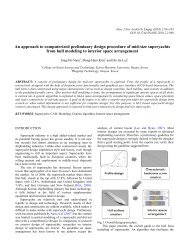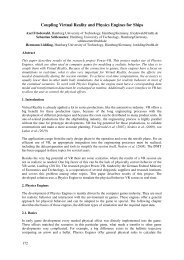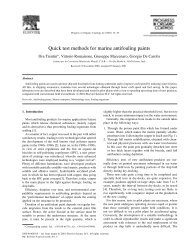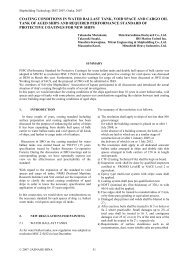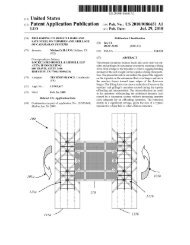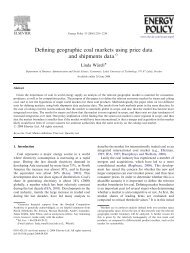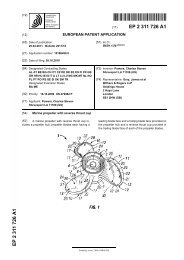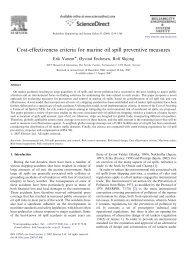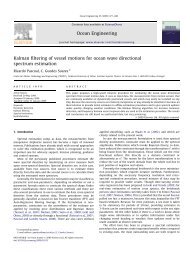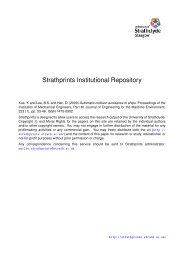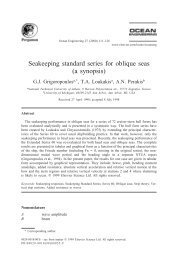Experimental research on friction-reduction with super-hydrophobic ...
Experimental research on friction-reduction with super-hydrophobic ...
Experimental research on friction-reduction with super-hydrophobic ...
You also want an ePaper? Increase the reach of your titles
YUMPU automatically turns print PDFs into web optimized ePapers that Google loves.
Journal of Marine Science and Applicati<strong>on</strong>, Vol.6, No.3, September 2007, pp.58-61<br />
DOI: 10.1007/s11804-007-7007-3<br />
<str<strong>on</strong>g>Experimental</str<strong>on</strong>g> <str<strong>on</strong>g>research</str<strong>on</strong>g> <strong>on</strong> fricti<strong>on</strong>-reducti<strong>on</strong> <strong>with</strong><br />
<strong>super</strong>-<strong>hydrophobic</strong> surfaces<br />
ZHAO Jia-peng, DU Xiang-dang and SHI Xiu-hua<br />
College of Marine Engineering, Northwestern Polytechnical University, Xi’an 710072, China<br />
1 Introducti<strong>on</strong> 1<br />
Abstract: Many recent studies have c<strong>on</strong>firmed the existence of liquid slip over particular types of solid surfaces,<br />
and these so-called <strong>super</strong>-<strong>hydrophobic</strong> surfaces have been shown to generate effective liquid slip because of the<br />
air trapped between the surface structures. In this paper, based <strong>on</strong> boundary layer theory, the microscopic<br />
structure of the <strong>super</strong>-<strong>hydrophobic</strong> surface is analyzed. The liquid slip effect <strong>on</strong> fricti<strong>on</strong>-reducti<strong>on</strong> over<br />
<strong>super</strong>-<strong>hydrophobic</strong> surfaces under various flow c<strong>on</strong>diti<strong>on</strong>s is investigated by experiments <strong>with</strong> a flume and water<br />
tunnel. The experimental results show that the greatest amount of drag-reducti<strong>on</strong> that can be achieved is 8.76% at<br />
a low Re.<br />
Key words: liquid slip; <strong>super</strong>-<strong>hydrophobic</strong>; boundary; fricti<strong>on</strong>-reducti<strong>on</strong>; Reynolds number.<br />
CLC number: 0353.5 Document code: A Article ID: 1671-9433(2007)03-0058-04<br />
Many surfaces in nature are highly <strong>hydrophobic</strong> and<br />
self-cleaning. Examples include the wings of<br />
butterflies and the leaves of plants such as cabbage.<br />
The well-known example of a <strong>hydrophobic</strong><br />
self-cleaning surface is the leaves of the lotus plant.<br />
Electr<strong>on</strong> microscopy of the surface of lotus leaves<br />
shows protruding nubs about 20~40 µm apart each<br />
covered <strong>with</strong> a smaller scale rough surface of<br />
epicuticular wax crystalloids [1] . Numerous studies<br />
have c<strong>on</strong>firmed that this combinati<strong>on</strong> of<br />
micrometer-scale and nanometer-scale roughness,<br />
al<strong>on</strong>g <strong>with</strong> the low surface energy material leads to<br />
<br />
apparent c<strong>on</strong>tact angle ( θ > 150 ), a low sliding<br />
angle and the self-cleaning effect [2] . Surfaces <strong>with</strong><br />
these properties are called “<strong>super</strong>-<strong>hydrophobic</strong>”.<br />
There’re many reports that certain <strong>hydrophobic</strong><br />
surfaces allow noticeable slip, <strong>with</strong> slip lengths in the<br />
range of 30 nm to 1 µm, theoretically, and<br />
experimentally. In particular, rough <strong>hydrophobic</strong><br />
surfaces, the so-called “<strong>super</strong>-<strong>hydrophobic</strong>” surfaces<br />
have been shown to generate an “effective” liquid slip<br />
because of the air trapped between the surface<br />
structures. There is currently c<strong>on</strong>siderable work in<br />
microfluidics aimed at utilizing liquid slip to reduce<br />
viscous drag [3] . Therefore, in this paper, the impact of<br />
fluid liquid slip <strong>on</strong> viscous drag is analyzed by theory<br />
and experiments.<br />
Received date: 2007-04-02.<br />
2 The mechanism of fricti<strong>on</strong>-reducti<strong>on</strong><br />
over <strong>super</strong>-<strong>hydrophobic</strong> surface<br />
Chang-Hwan Choi [6] , etc. have proposed<br />
<strong>super</strong>-<strong>hydrophobic</strong> surface fluid flow in the<br />
micro-structure model shown in Fig.1, the Couette<br />
flow in which an air layer separates liquid from a wall<br />
by the sharp tips of the <strong>hydrophobic</strong> posts, riding<br />
mainly over air, the liquid is expected to flow over the<br />
solid surface experiencing little fricti<strong>on</strong>. A slip length<br />
δ due to the pure air layer of thickness b can be<br />
represented by<br />
δ = b(<br />
μ1μa− 1) , (1)<br />
where µ 1 and µ a are the viscosities of liquid and<br />
air, respectively, an obvious effective slip is expected<br />
due to the sizable viscosity difference between liquid<br />
and air. C<strong>on</strong>tact angle θ <strong>on</strong> the side surfaces of the<br />
posts, balancing <strong>with</strong> the liquid pressure. The posts<br />
need to be tall enough so that the liquid does not touch<br />
the bottom surface between posts and also need to be<br />
populated densely enough. The pitch should be small<br />
enough, so that the surface tensi<strong>on</strong> of the warped<br />
meniscus <strong>with</strong>stands the pressure in the liquid.<br />
The slip effect <strong>on</strong> the surface entails meaningful<br />
fricti<strong>on</strong>-reducti<strong>on</strong> under various flow c<strong>on</strong>diti<strong>on</strong>s.<br />
Chang-Hwan Choi also proposed the relati<strong>on</strong>ship<br />
between fricti<strong>on</strong> and liquid slip length [6] .
ZHAO Jia-peng, et al: <str<strong>on</strong>g>Experimental</str<strong>on</strong>g> <str<strong>on</strong>g>research</str<strong>on</strong>g> <strong>on</strong> fricti<strong>on</strong>-reducti<strong>on</strong> <strong>with</strong> <strong>super</strong>-<strong>hydrophobic</strong> surfaces 59<br />
h<br />
b<br />
liquid<br />
air<br />
Hydrophobic<br />
structures<br />
τ<br />
slip<br />
1<br />
|<br />
Coquette<br />
=<br />
, (2)<br />
τ<br />
no-slip<br />
1 + ( δ h)<br />
where δ is the slip length, h is the boundary layer<br />
thickness, τ<br />
slip<br />
andτ no-slip<br />
are the shear stresses at a<br />
wall when slip and no-slip boundary c<strong>on</strong>diti<strong>on</strong>s are<br />
applied respectively.<br />
3 Experiment<br />
δ<br />
Fig.1 C<strong>on</strong>cept of large effective slip by<br />
<strong>super</strong>-<strong>hydrophobic</strong> surface in Coquette flow<br />
3.1 Preparati<strong>on</strong> of <strong>super</strong>-<strong>hydrophobic</strong> surface and<br />
models<br />
The preparati<strong>on</strong> of <strong>super</strong>-<strong>hydrophobic</strong> surface of the<br />
nano-structures requires two c<strong>on</strong>diti<strong>on</strong>s: 1) Preparati<strong>on</strong><br />
of nano-structures; 2) modificati<strong>on</strong> to the nano-structures<br />
by the material of low surface energy.<br />
1) There are two general methods for preparati<strong>on</strong> of<br />
nano-structures: anodic oxidati<strong>on</strong> method and<br />
chemical corrosi<strong>on</strong> method. The anodic oxidati<strong>on</strong><br />
method is using electrochemical methods to prepare<br />
the nano-alumina structure <strong>on</strong> aluminum plate; the<br />
chemical corrosi<strong>on</strong> method is using chemical<br />
corrosi<strong>on</strong> <strong>on</strong> aluminum plate.<br />
2) Modificati<strong>on</strong> of low surface energy materials can be<br />
divided into FAS (fluorine-c<strong>on</strong>taining silane) and<br />
fluoro-coatings. FAS soluti<strong>on</strong> plays a role of catalyst in<br />
the hydrolysis. It could be the low energy surface, hich<br />
is the level of molecular weight in the basement that<br />
had been processed. Fluoro-coating is made of<br />
fluoro-resin, curing agent, FAS, poly tetra fluoro<br />
ethylene(PTFE) and organic solvent c<strong>on</strong>fected<br />
according to a certain proporti<strong>on</strong>.<br />
θ<br />
α<br />
d<br />
V<br />
In this paper, firstly, nano-alumina structures were<br />
prepared in anodic oxidati<strong>on</strong> method, and then<br />
modified by fluoro-coatings. The prepared<br />
<strong>super</strong>-<strong>hydrophobic</strong> surface has greater c<strong>on</strong>tact angle<br />
<strong>with</strong> water droplet, a low sliding angle, having good<br />
wear-resistance.<br />
3.2 <str<strong>on</strong>g>Experimental</str<strong>on</strong>g> program and devices<br />
There is a great difference between laminar and<br />
turbulent boundary layer in viscous-fricti<strong>on</strong>. Therefore,<br />
experimental <str<strong>on</strong>g>research</str<strong>on</strong>g>es were d<strong>on</strong>e separately.<br />
a) <str<strong>on</strong>g>Experimental</str<strong>on</strong>g> <str<strong>on</strong>g>research</str<strong>on</strong>g> of fricti<strong>on</strong>-reducti<strong>on</strong> <strong>on</strong><br />
laminar boundary layer. The experiment was d<strong>on</strong>e in<br />
the rotary flume at the Physics Laboratory of<br />
Northwestern Polytechnical University. <str<strong>on</strong>g>Experimental</str<strong>on</strong>g><br />
methods: Install the rotor <strong>with</strong> <strong>super</strong>-<strong>hydrophobic</strong><br />
coatings separately, and measure torque values at<br />
different speeds by using rotary viscosimeter (mode<br />
NDJ-1). The rotor diameter is 26 mm, length is 91 mm.<br />
375<br />
Strain<br />
Flat model<br />
Fig.2 C<strong>on</strong>cept of drag testing system<br />
Chamfer 16<br />
500<br />
Signal acquisiti<strong>on</strong> system<br />
360<br />
Chamfer 40 250<br />
Flow directi<strong>on</strong><br />
Liquid<br />
(Arc transiti<strong>on</strong> to the fr<strong>on</strong>t, thickness: 10, unit: mm)<br />
Fig.3 Flat model<br />
b) <str<strong>on</strong>g>Experimental</str<strong>on</strong>g> <str<strong>on</strong>g>research</str<strong>on</strong>g> of fricti<strong>on</strong>-reducti<strong>on</strong> <strong>on</strong><br />
turbulent boundary layer. The experiment was d<strong>on</strong>e in<br />
the water tunnel at the College of Marine Engineering,<br />
Northwestern Polytechnical University. Main<br />
performance parameters for the water tunnel: the size<br />
of working secti<strong>on</strong> is Φ 400 mm × 2 000 mm , the<br />
speed of working secti<strong>on</strong> is 0~18m/s. <str<strong>on</strong>g>Experimental</str<strong>on</strong>g><br />
methods: made experimental models associate <strong>with</strong>
60<br />
3-comp<strong>on</strong>ent internal strain gage balance and installed<br />
in working secti<strong>on</strong> (Fig.2).Drag values were measured<br />
at different water velocities. There are two models for<br />
this experiment, aluminum alloy plate (Fig. 3) and<br />
rotary model (Fig. 4).<br />
66mm<br />
842mm<br />
Head and tail are two-parameter elliptic curves,<br />
sticky wet area: 0.162 0 m 2<br />
Fig.4 Rotary model<br />
4 <str<strong>on</strong>g>Experimental</str<strong>on</strong>g> results and discussi<strong>on</strong><br />
4 4<br />
1) Under laminar flow c<strong>on</strong>diti<strong>on</strong> (Re= 10 ~ 2 × 10 ),<br />
Fig.5 shows that the greatest amount of drag-reducti<strong>on</strong><br />
<strong>on</strong> <strong>super</strong>-<strong>hydrophobic</strong> surface can be achieved by<br />
8.76% at low Re.<br />
Fig5. <str<strong>on</strong>g>Experimental</str<strong>on</strong>g> results of laminar flow<br />
6 6<br />
2) Under Turbulent flow c<strong>on</strong>diti<strong>on</strong> (Re= 2× 10 ~5× 10 ),<br />
Fig. 6 shows, to the flat model, there was not<br />
1<br />
fricti<strong>on</strong>-reducti<strong>on</strong> at 4~8m s −<br />
⋅ speed, but there<br />
1<br />
was a little drag-reducti<strong>on</strong> after the 8 m s −<br />
⋅ speed.<br />
Fig.7 shows, to the rotary model, there was not<br />
drag-reducti<strong>on</strong> but appeared a little more<br />
drag-increasing. And the measure of drag-increasing<br />
increased <strong>with</strong> water speed growth. For these results,<br />
the turbulent boundary is the main part of the whole<br />
boundary layer at large Reynolds number to the flat<br />
and rotary models. People have <str<strong>on</strong>g>research</str<strong>on</strong>g>ed <strong>on</strong> the<br />
structure of turbulent boundary layer for a l<strong>on</strong>g time<br />
and drawn a c<strong>on</strong>clusi<strong>on</strong> that near wall regi<strong>on</strong> (the<br />
regi<strong>on</strong> between viscous sublayer and transiti<strong>on</strong> layer),<br />
the process of low-speed stream busting into outer<br />
turbulent boundary layer is the initial burst to the<br />
entire turbulence. This process has created a cycle of<br />
Journal of Marine Science and Applicati<strong>on</strong>, Vol.6, No.3, September 2007<br />
bursting the turbulent boundary layer and c<strong>on</strong>sumed<br />
the energy of outer flow. Therefore, the burst in the<br />
near wall regi<strong>on</strong> is an essential process to the whole<br />
turbulent boundary layer. For drag-reducti<strong>on</strong>, the most<br />
important thing is that it reduced turbulent burst in the<br />
boundary layer and restricted the three-dimensi<strong>on</strong>al<br />
boundary layer flow. Based <strong>on</strong> the theory and<br />
experiments, it is of no effect to weaken either the<br />
strength of the vortex flow to the <strong>super</strong>-<strong>hydrophobic</strong><br />
surfaces, or the frequency and intensity of turbulent<br />
burst. Instead, because of this n<strong>on</strong>-wetting property<br />
and the smoothness surface of <strong>super</strong>-<strong>hydrophobic</strong><br />
surfaces, the instability and disturbance of flow in the<br />
near wall regi<strong>on</strong> were increased, so the frequency and<br />
intensity of low-speed stream busted into outer<br />
turbulent boundary layer in near wall regi<strong>on</strong> were also<br />
increased. Thus, increasing the development of<br />
turbulent boundary layer and the process of the<br />
boundary layer momentum exchange, accordingly, the<br />
increase of pulse of pressure and rate led to the<br />
increase of fricti<strong>on</strong>.<br />
Fig.6 <str<strong>on</strong>g>Experimental</str<strong>on</strong>g> results of turbulence flow <strong>with</strong> flat plate model<br />
Fig.7 <str<strong>on</strong>g>Experimental</str<strong>on</strong>g> results of turbulence flow <strong>with</strong> rotary model<br />
5 C<strong>on</strong>clusi<strong>on</strong>s<br />
1) Under laminar flow c<strong>on</strong>diti<strong>on</strong>, it has been proved
ZHAO Jia-peng, et al: <str<strong>on</strong>g>Experimental</str<strong>on</strong>g> <str<strong>on</strong>g>research</str<strong>on</strong>g> <strong>on</strong> fricti<strong>on</strong>-reducti<strong>on</strong> <strong>with</strong> <strong>super</strong>-<strong>hydrophobic</strong> surfaces 61<br />
that there is direct fricti<strong>on</strong>-reducti<strong>on</strong> <strong>on</strong> the<br />
<strong>super</strong>-<strong>hydrophobic</strong> surface from theory and<br />
experiments, achieving the purpose of reducing<br />
viscous resistance.<br />
2) Under turbulent flow c<strong>on</strong>diti<strong>on</strong>, because of this<br />
n<strong>on</strong>-wetting property and smoothness surface of<br />
<strong>super</strong>-<strong>hydrophobic</strong> surfaces, the instability and<br />
disturbance of flow in the near wall regi<strong>on</strong> are<br />
increased, accordingly, the increase of pulse of<br />
pressure and rate lead to the increase of fricti<strong>on</strong>.<br />
References<br />
[1] BARTHLOTT W, NEINHUIS C. Purity of the sacred lotus,<br />
or escape from c<strong>on</strong>taminati<strong>on</strong> in biological surfaces[J].<br />
Planta, 1997,202:1–8.<br />
[2] NAKAJIMA A, HASHIMOTO K, WATANABE T. Recent<br />
studies <strong>on</strong> Super <strong>hydrophobic</strong> films[J]. M<strong>on</strong>atsh Chem.<br />
2001,132:31–41.<br />
[3] YANG J, KWOK D Y. Effect of liquid slip in electrokinetic<br />
parallel-plate microchannel flow[J]. Colloid Interface Sci.<br />
2003, 260:225–33.<br />
applicati<strong>on</strong> in low load c<strong>on</strong>tacts. Proceedings of the<br />
Instituti<strong>on</strong> of Mechanical Engineers , Part J: Journal of<br />
Engineering Tribology , 2003, 217(1):15–26.<br />
[5] SPIKES H A. The half-wetted bearing, part I—extended<br />
Reynolds equati<strong>on</strong>[J]. Proceedings of the Instituti<strong>on</strong> of<br />
Mechanical Engineers, Part J: Journal of Engineering<br />
Tribology ,2003, 217(1):1–14.<br />
[6] CHOI C H, KIM C J. Large slip of aqueous liquid flow over<br />
a nano engineered <strong>super</strong> <strong>hydrophobic</strong> surface. Physical<br />
Review Letters, 2006, 96( 66001):1-4.<br />
ZHAO Jia-peng was born in 1981. He is a<br />
doctoral student at Northwestern Polytechnical<br />
University. His current <str<strong>on</strong>g>research</str<strong>on</strong>g> interests include<br />
multidisciplinary optimizati<strong>on</strong> design and its<br />
applicati<strong>on</strong> in underwater vehicles.<br />
SHI Xiu-hua was born in 1945. She is a<br />
Professor of Northwestern Polytechnical<br />
University, Doctoral Supervisors. Her main<br />
<str<strong>on</strong>g>research</str<strong>on</strong>g><br />
weap<strong>on</strong>s.<br />
area is <str<strong>on</strong>g>research</str<strong>on</strong>g> <strong>on</strong> underwater



